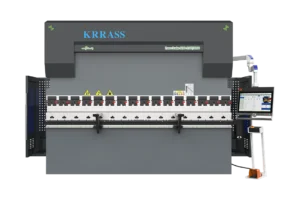Manual Press Brake is a machine designed to form folds and bends in sheet metal. The bends are formed to a predetermined angle and are created by clamping the sheet between a combination punch and die. The punch is then forced down into the die, and the sheet of metal bends accordingly.
Press brakes are available in different types, usually described by the nature of the force used to form the bends. There are mechanical, hydraulic, pneumatic and servo-electric types of press brakes. There are also manually operated hand press brakes. These tend to be smaller machines where high pressure forces for metal bending are not necessary.
The maximum pressures in a press brake can usually be measured in hundreds of tons. Hydraulic press brakes are the most popular type today, but up until 50 or 60 years ago it was mechanical press brakes that dominated.

Metal of all kinds have been worked by man for thousands of years. Iron was shaped and formed through hammering, initially. In the late 18th century, iron sheets began to be produced in rolling mills. By the mid 19th century, metallurgy processes had improved to the point where sheet metal was more reliable, and metal workers began to form and bend it into specific angles and shapes.
This was initially done through hand forming, or through a lead strap and form block, or mould method, but increasingly sheet metal was bent and formed with the aid of specially designed machines.
The straight and box and pan folders are the simplest types of machine for bending sheet metal. They are still used in small workshops, mainly with light gauge sheet metal, and while hydraulic actuation and computer numerical control (CNC) are possible, more often it is a simple hand operated machine.
The old style, hard to adjust and guard, mechanical press brake uses an electric-powered flywheel to build up the tonnage pressure for sheet metal forming. The flywheel is linked to the moving part of the press brake, the ram, which can be engaged and disengaged as required. The disengaged flywheel will build up inertia that can be utilised to cause the ram to move up and down when re-engaged.
The hydro-mechanical press brake is broadly similar to the mechanical version. Instead of having a flywheel, it is powered by a hydraulic motor that turns an eccentric shaft, which in turn causes the ram to move up and down.
The hydraulic press brake, unlike all the other types of press brake, which are down-acting only, can be either up-acting or down-acting. It employs a hydraulic pump that move the ram through the action of hydraulic cylinders. Servo-electric and pneumatic press brakes are usually light tonnage machines.
The final press brake choice, and arguably the most accurate and fast acting is the Servo / belt drive E –Brake. It uses energy efficient servo drives to drive the beam beam down and uniquely applies the bending force evenly across the machine as opposed to a single or two pressure point system.
At KRRASS, we sell all types of Manual Press Brake, the older designs as used machines and the Servo option in both new and used. Our used Manual Press Brake selection is constantly changing but typically includes machines from all the major manufacturers. These include Adira, Amada, Beyeler, Bystronic, Bronx,KRRASS, Cincinatti, Darley, Edwards Pearson, Guifil, Haco, KB, LVD, Mebusa, Megaform, Promecam, Pullmax, Safan, and Trumpf.
Learn more about our products, please visit and subscribe to our Youtube channel





